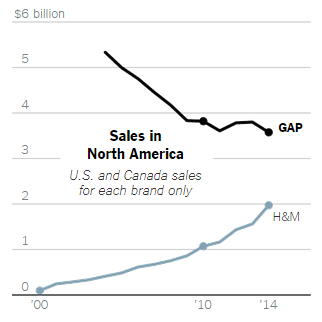It’s always a little funny when mainstream media reports on marketing and social media trends. This morning an article in Business Insider touted that Instagram and other social media sites are “killing retail as we know it” in an admittedly (and intentionally) attention-grabbing headline. The piece cited the upcoming closures of hundreds of retail stores of brands like Gap, Abercrombie & Fitch, and American Eagle in the USA as proof that social media is contributing to modern-day consumers becoming more fickle, and wanting the latest trends right here and now, which is something that these brands just can’t deliver. While this may be true, it’s only a small part of the story, and there are a number of things we can learn from Gap’s unfortunate demise over the past 12 months.
Remember that social should be a conversation
Gap appears to be an example of a brand that’s well and truly stuck in a one-sided conversation with their audience – making it, well… not even a conversation at all. Their #DressNormal campaign was apparently a huge flop, yet it’s still there, emblazoned in their Instagram bio. Rather than forcing a hashtag on their audience just because their marketing company told them it was a good idea, they should instead be asking themselves: In 2015, do the majority of shoppers really want to “dress normal”? And if they do, do they want to do it wearing Gap clothing? Either way, they definitely want to be dressing in good quality clothing – another area that Gap appears to be is struggling with, if their social media followers are anything to go by.

Graph – NY Times
“But look! We do social! Why don’t people love us!?!”
Take a look at Gap’s Instagram feed, and you’ll get an idea of a brand that’s hip, young, modern and effortlessly stylish. Go into a store, however, and you’ll see a completely different story. Dowdy, over-priced basics, which don’t even have the same quality as they used to. What’s happened here is their online presence is not mirroring, or enhancing, their offline presence.
“The inconsistency between each brand’s in-store and digital experiences represents a disconnect with the customer,” says Andy Wong, co-founder of digital retail partner Mobispoke in a recent Digiday article. It’s evidence that simply refreshing your online presence won’t save your brand if it’s fundamentally not relevant to what consumers want anymore.
Do you need a new social media strategy, or new brand strategy – or both?
There are times when you need a new social media strategy, and times when you need a completely new brand strategy, and at this point in time, Gap and other American brands appear to need both. There’s the idea that social media has left people a little too spoiled for choice when it comes to their buying decisions. For consumers, it’s great, but some brands have a tendency to complain about how social is making it tough for them to stay competitive in a world where consumers can see and access the latest trends from overseas faster than ever before. But by failing to adapt to these new trends (and we’re not talking about just fashion trends) and change up their product and service offering, brands are really just “killing themselves”. Rather than blaming social media for their downfall, these brands need to rethink their strategies and how they can bring both their offline and online image into 2015.
